US LED Market Size
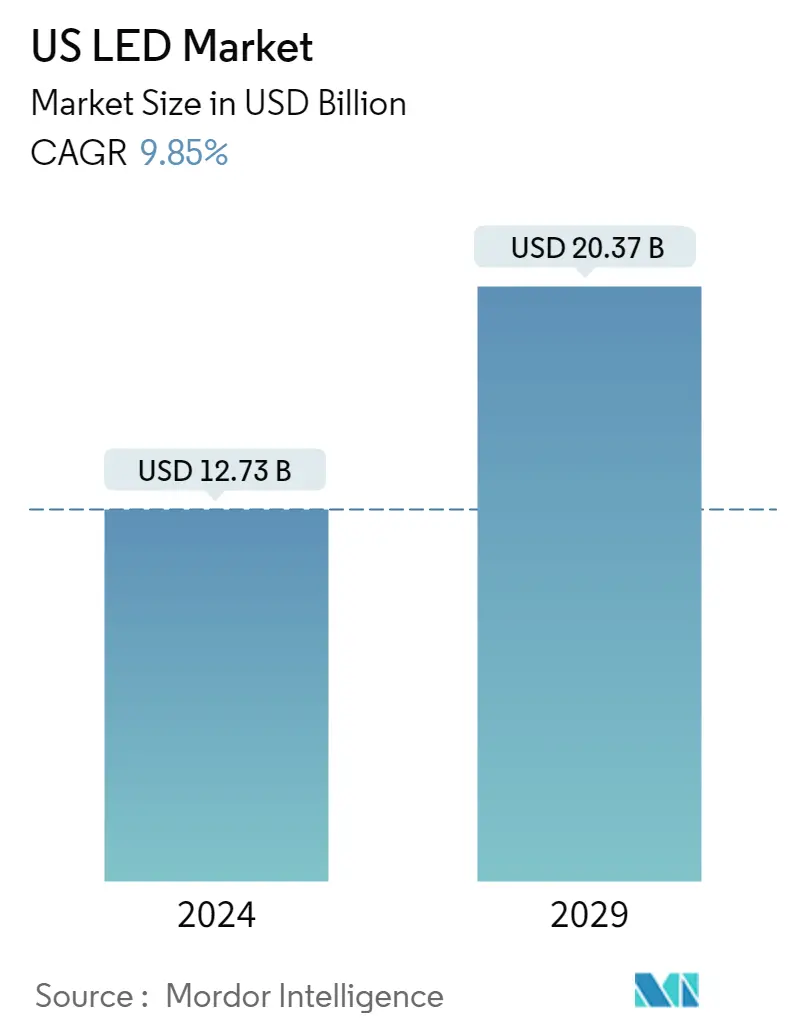
| Study Period | 2018 - 2028 |
| Base Year For Estimation | 2021 |
| Market Size (2023) | USD 11.59 Billion |
| Market Size (2028) | USD 18.54 Billion |
| CAGR (2023 - 2028) | 9.85 % |
| Market Concentration | Low |
Major Players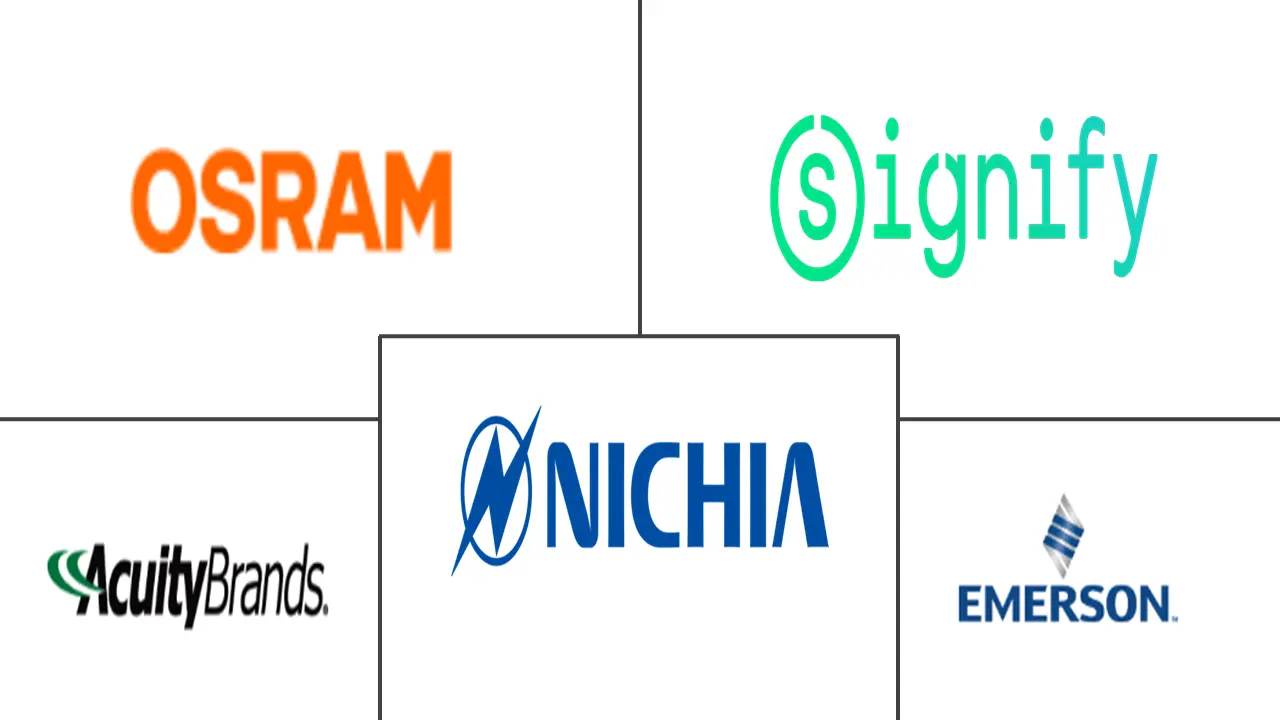
*Disclaimer: Major Players sorted in no particular order |
Need a report that reflects how COVID-19 has impacted this market and its growth?
US LED Market Analysis
The United States LED Market size is estimated at USD 11.59 billion in 2023, and is expected to reach USD 18.54 billion by 2028, growing at a CAGR of 9.85% during the forecast period (2023-2028).
The increasing demand for energy-efficient lighting systems, declining prices of LED (light emitting diode) products, and stringent government regulations are the major factors driving the adoption of LED lighting in the United States. LEDs are undergoing rapid technological and economic development as a new source of illumination in the country by investing in the sector. The US government is one of the significant adopters, innovators, and investors in the global LED market. LED lighting is available in various industrial and home products in the domestic space, and its demand has increased significantly.
- According to the US Department of Energy, the majority of the projected energy savings in 2035 may be driven by the increasing usage of LED (light emitting diode) lighting in industrial buildings, commercial and outdoor lighting applications characterized by extended operating hours, and high light output.
- One of the main factors influencing the adoption of LED lighting in the nation is the rising demand for energy-efficient lighting systems, which is being met by falling prices for LED goods and strict government restrictions. LEDs have seen tremendous technological and economic growth as a new source of illumination in the nation, spurring investment in the industry. One of the major investors, adopters, and inventors in the worldwide LED industry is the United States. In the domestic market, LED lighting is already accessible in a wide range of consumer and business goods, and the selection is steadily expanding.
- Additionally, because of advantages like high power efficiency, a prolonged lifespan, adjustability and durability, and environmental friendliness, LED lights are increasingly being utilized in a variety of settings, including government buildings, hospitals, stadiums, shopping malls, educational institutions, airports, trains, theaters, and various places. This has increased LED light sales. Further, due to their energy efficiency, LED lights may significantly reduce the number of traditional fuels needed for lighting in less developed nations. Due to infrastructure growth across the United States, more lighting options are required, and LED lights are the ideal alternative. As a result, there is a noticeable increase in demand for LED lights.
US LED Market Trends
This section covers the major market trends shaping the US LED Market according to our research experts:
Residential Sector to Hold Significant Market Share
- The residential segment occupies a significant market share and is expected to retain its position during the forecast period. LEDs have been witnessing increasing adoption in the residential sector in the United States. Although residential and commercial end users are the primary adopters of the technology, LEDs' high efficiency and directional nature also propel their industrial adoption. LED technology has a vast scope for improvement. Therefore, it attracts many new players to the market studied. Light quality is one of the most significant competitive factors among regional manufacturers, as energy savings are no longer the primary driver for product development.
- Moreover, government regulations are significant factors in shifting the residential consumers' affinity toward more efficient products, such as LED lighting. Despite the increasing market and regulatory uncertainties, residential lighting represents a significant share of ratepayer-funded energy efficiency electricity savings.
- However, most energy efficiency programs have transitioned to promote solid-state LED lamps instead of CFLs. This transition may accelerate further because of the new ENERGY STAR v2.0 lighting specifications that are effectively limited to LED lamps. LEDs gained tremendous momentum and a higher market share, while future CFL production may become increasingly unlikely.
- Incandescent light bulbs have been used traditionally in the United States for household lighting. The basic technology in incandescent bulbs has mostly stayed the same, although they convert less than 10% of their energy input into light. Improving light bulb performance can reduce overall energy usage in the United States, further driving the demand for LED lighting products.
- Further, closet shed lights and other home applications require one or two LED lighting for operation and are often battery-operated. Due to the increasing consumer demand, several market players are offering solutions to capitalize on the opportunity. For instance, the US-based revolution lighting offers ambient luminaires for natural, flat, and ambient lighting needs, ideal for residential settings.
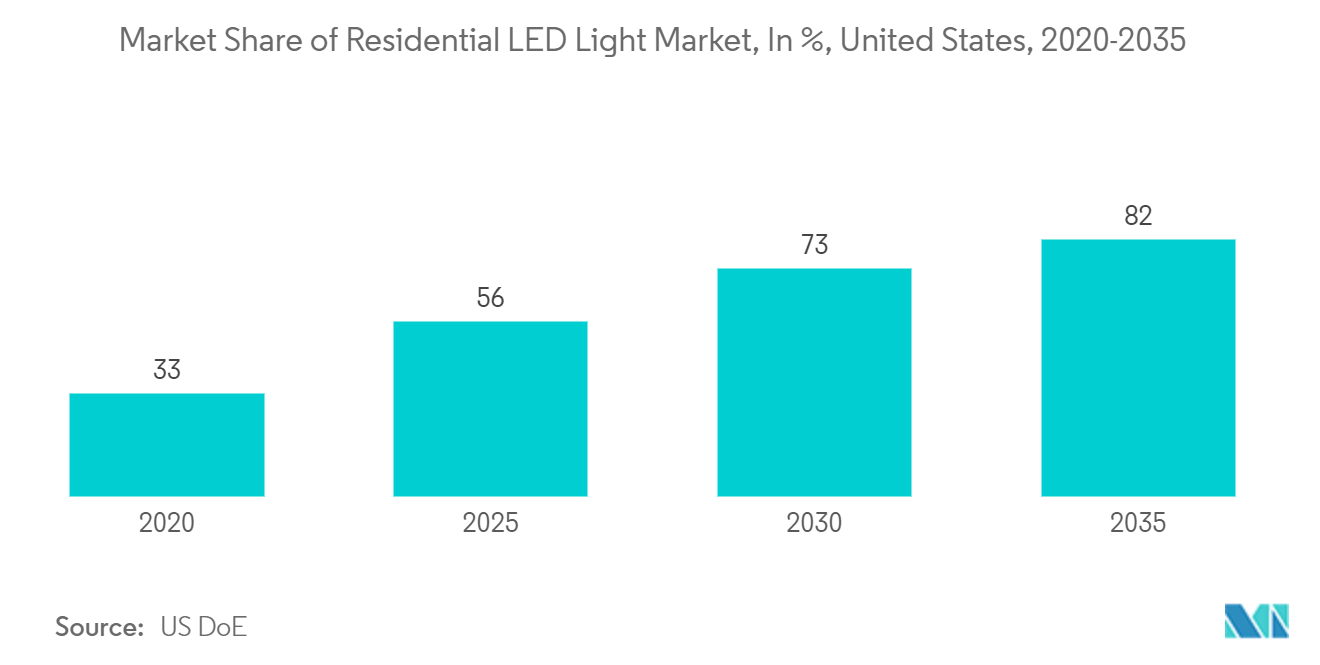
Outdoor LED to Witness Significant Growth
- Outdoor LED (light emitting diode) lighting in the United States covers major areas like roadway, parking, and exterior building lighting to create a sense of personal security, provide proper illumination for pedestrian and vehicular traffic, and attract attention to businesses and spaces.
- Several government initiatives, product innovations, public-private deals, and improvisations are expected to boost the demand for enhanced street lighting solutions in the United States, thus boosting the market growth. For instance, the Airport Logistics Access Project 70/75, led by the Montgomery County TID (Transportation Improvement District), is considering a roadway project to improve access to the DIA (Dayton International Airport) to address the significant growth in activity in the distribution sector, manufacturing, and the logistics.
- Moreover, the Michigan Department of Transportation (MDT) partnered with Freeway Lighting Partner LLC signing a 15 years contract to finance, build and design the improvements on existing tunnel lighting systems and freeway for maintaining the current and enhanced lighting system for the remaining operating and maintenance period. Freeway Lighting Partner LLC will hand MDOT back the lighting systems near LLC at the end of the contract term.
- Additionally, innovative city projects have gained momentum over the last decade. More municipalities across the country have launched various digital transformation initiatives by the US government to realize the benefits of utilizing innovative technology to manage several assets and resources that ultimately enhance city operations.
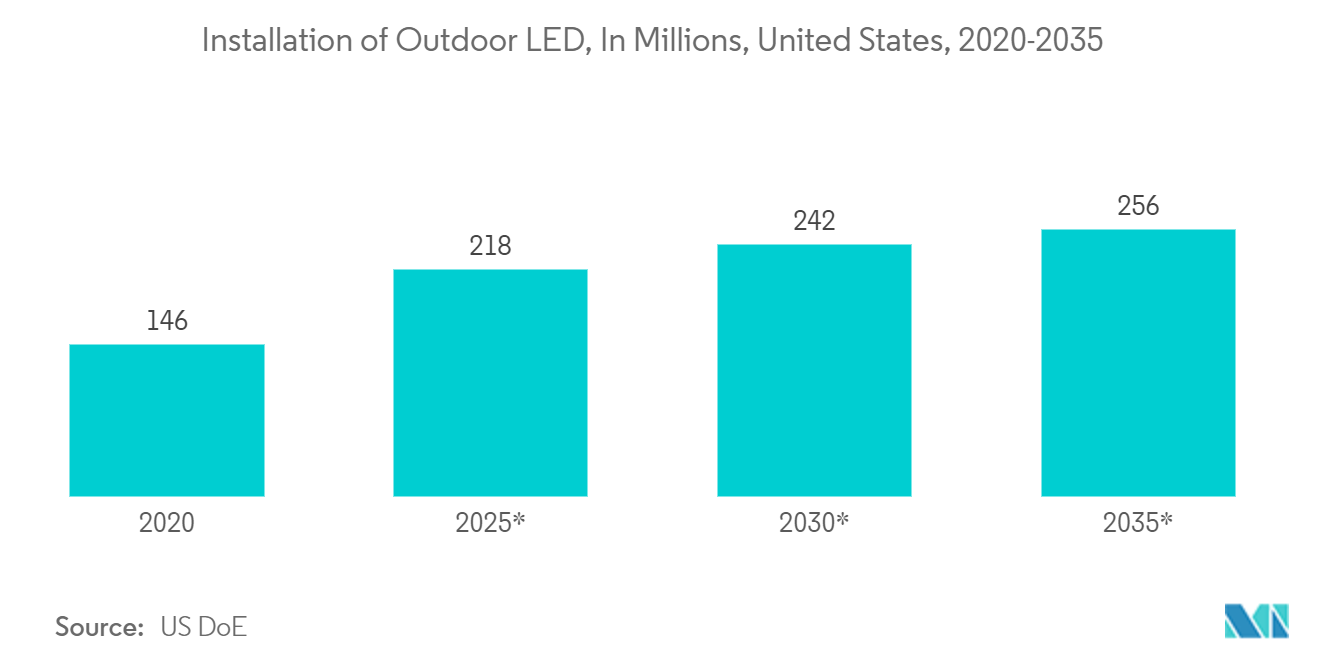
US LED Industry Overview
The US LED market is competitive in nature. The market is highly concentrated due to various small and large players. All major players account for a significant market share and focus on expanding their consumer base worldwide. Some of the significant players in the market are Emerson Electric Co., Signify Holding (Philips Lighting), OSRAM Sylvania Inc. (OSRAM Licht Group), Nichia Corporation, Acuity Brands Inc., and many more.
- March 2022: Signify collaborated with Perfect Plants on cannabis. The company was competing for a Dutch license for the legal cultivation of cannabis and invested in facilities for research and production. Signify supplies flexible GreenPower LED systems and specialist knowledge. The two new climate cells are equipped with dimmable Philips GreenPower LED toplighting compact to grow lights and the Philips GrowWise Control System, providing a light system that can be used effectively and efficiently in every growth phase.
- March 2022: Signify will provide GreenPower LED technology for Iceland’s first vertical farm, VAXA. Vertical farming agriculture is carried out in controlled indoor conditions, where crops are grown under LED lighting in systems of stacked trays. VAXA uses Signify’s Philips GreenPower LED production modules. VAXA’s partnership with Signify’s horticultural lighting experts has been vital as it even went beyond Signify’s provision of hardware.
US LED Market Leaders
Emerson Electric Co
Signify Holding (Philips Lighting)
OSRAM Sylvania Inc. (OSRAM Licht Group)
Nichia Corporation
Acuity Brands Inc.
*Disclaimer: Major Players sorted in no particular order
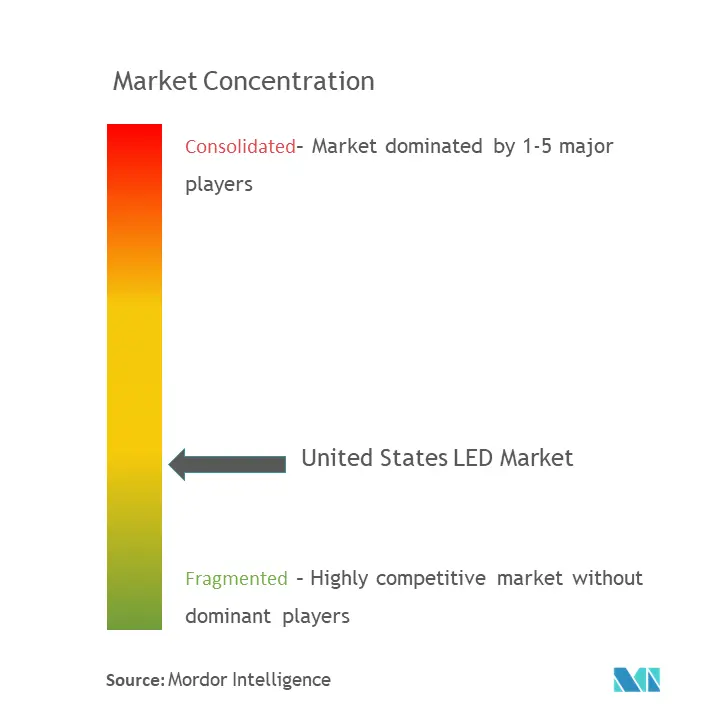
US LED Market News
- October 2022: Nichia announced that the H6 Series of LEDs is prepared for a new era of LED adoption where the focus on the quality of light can take center stage without compromise. However, the H6 Series of LEDs capitalizes on Nichia’s 50+ years of phosphors and LED expertise and technology, combined with current TriGain technology. Nichia and its partners agreed to new licensing agreements that will now expand the markets for Nichia’s H6 Series of LEDs into residential lighting applications globally, in addition to commercial lighting applications.
- March 2022: Signify strengthened the floriculture team of Horticulture LED Solutions. Large-scale research and experience by the company Signify showed that growers could use Philips LED grow lights to grow crops such as roses, potted plants, chrysanthemums, and bedding plants with high quality, yield, and predictability of the crops and lower energy costs.
US LED Market Report - Table of Contents
1. INTRODUCTION
1.1 Study Assumptions and Market Definition
1.2 Scope of the Study
2. RESEARCH METHODOLOGY
3. EXECUTIVE SUMMARY
4. MARKET INSIGHTS
4.1 Market Overview
4.2 Industry Attractiveness - Porter's Five Forces Analysis
4.2.1 Bargaining Power of Suppliers
4.2.2 Bargaining Power of Consumers
4.2.3 Threat of New Entrants
4.2.4 Threat of Substitutes
4.2.5 Intensity of Competitive Rivalry
4.3 Impact of COVID-19 on the LED Market
5. MARKET DYNAMICS
5.1 Market Drivers
5.1.1 Increasing Demand for Energy-efficient Lighting Systems and Stringent Government Regulations
5.1.2 Growing Industrial Applications of LED
5.2 Market Challenges
5.2.1 Volatile Economic Situations, Combined with the Dominance of Conventional Lights
5.2.2 High Initial Investment
6. MARKET SEGMENTATION
6.1 By Product Type
6.1.1 Lamps
6.1.2 Luminaires
6.2 By Application
6.2.1 Indoor
6.2.2 Outdoor
6.3 By Distribution Channel
6.3.1 Direct Sales
6.3.2 Wholesale Retail
6.4 By End-user Vertical
6.4.1 Residential
6.4.2 Commercial Office Spaces
6.4.3 Industrial
6.4.4 Retail
6.4.5 Hospitality
6.4.6 Healthcare and Other Verticals
7. COMPETITIVE LANDSCAPE
7.1 Company Profiles
7.1.1 Emerson Electric Co.
7.1.2 Signify Holding (Philips Lighting)
7.1.3 OSRAM Sylvania Inc. (OSRAM Licht Group)
7.1.4 Nichia Corporation
7.1.5 Acuity Brands Inc.
7.1.6 Cree Lighting (Ideal Industries Inc.)
7.1.7 ABB Inc.
7.1.8 Savant Systems Inc.
7.1.9 Hubbell Incorporated
7.1.10 US LED Ltd
7.1.11 Titan LED Lighting Solutions
- *List Not Exhaustive
8. INVESTMENT ANALYSIS
9. FUTURE OF THE MARKET
US LED Industry Segmentation
The US LED market is segmented by product type, which includes lamps and luminaires used across indoor and outdoor applications. The report also considers the distribution channels, including direct sales and wholesale retail, through which these lights are sold in the market. Moreover, the report also includes market estimations based on end-user verticals (residential, commercial office spaces, industrial, retail, hospitality, and healthcare) and by country. LED stands for light-emitting diode.
LED lighting products produce approximately 90% more efficiently than other light bulbs, such as fluorescent and incandescent lights. About 95% of the energy in LEDs is converted into light, and only 5% is wasted as heat, leading consumers to opt for more efficient lighting.
The market sizes and forecasts are provided in terms of value (USD million) for all the above segments.
| By Product Type | |
| Lamps | |
| Luminaires |
| By Application | |
| Indoor | |
| Outdoor |
| By Distribution Channel | |
| Direct Sales | |
| Wholesale Retail |
| By End-user Vertical | |
| Residential | |
| Commercial Office Spaces | |
| Industrial | |
| Retail | |
| Hospitality | |
| Healthcare and Other Verticals |
US LED Market Research FAQs
How big is the US LED Market?
The US LED Market size is expected to reach USD 11.59 billion in 2023 and grow at a CAGR of 9.85% to reach USD 18.54 billion by 2028.
What is the current US LED Market size?
In 2023, the US LED Market size is expected to reach USD 11.59 billion.
Who are the key players in US LED Market?
Emerson Electric Co, Signify Holding (Philips Lighting), OSRAM Sylvania Inc. (OSRAM Licht Group), Nichia Corporation and Acuity Brands Inc. are the major companies operating in the US LED Market.
US LED Lighting Industry Report
Statistics for the 2023 US LED Lighting market share, size and revenue growth rate, created by Mordor Intelligence™ Industry Reports. US LED Lighting analysis includes a market forecast outlook to 2028 and historical overview. Get a sample of this industry analysis as a free report PDF download.
